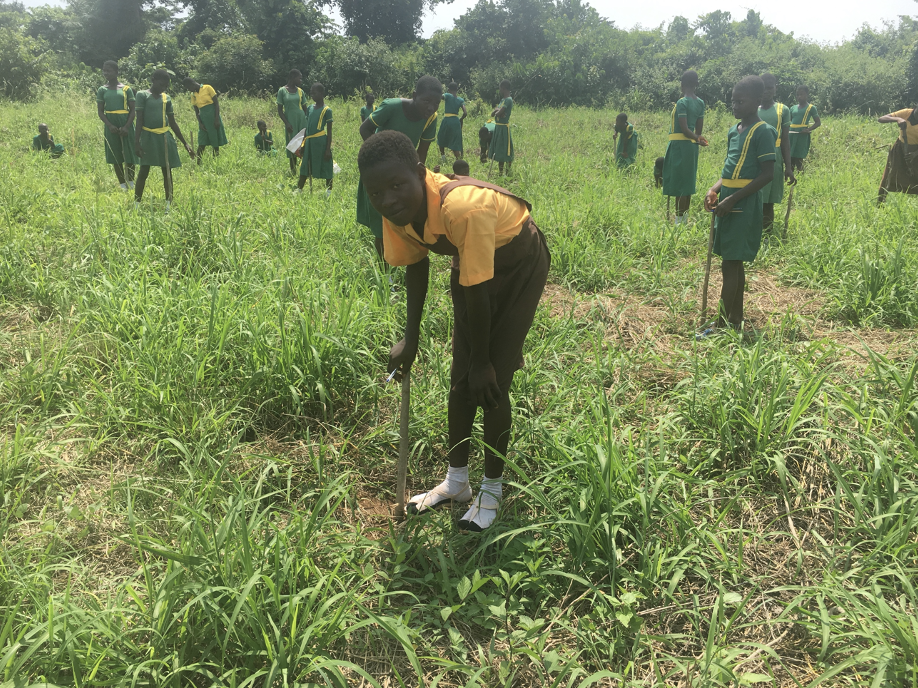It’s About Time We Discuss the Impacts of Climate Crisis on Girls’ Education
A Young Girl Plants Moringa Trees in Egbo
The physical impacts of climate change on weather events, global temperatures, resource depletion, and agriculture are highly popularized within the media and reasonably well-known within populations, at least in the United States. However, invisible in many discussions are its intangible consequences on girls’ (and children’s) education. Extreme weather events provide a major interruption to 12 years of quality education for girls, with the poorest and most vulnerable girls bearing the heaviest burden. Research found that 81% of the children in the poorest households in Ethiopia at the time of study had experienced at least 1 extreme weather event, compared to just 22% of children in the least poor households.
First, global warming and extreme weather events can significantly damage and destroy crops. These crop failures can then impact the marketable yield for families who rely on selling their harvested crops for income, especially damaging for households who are less resilient to financial hardships. With reduced household income and no access to affordable credit to pay for school fees, materials, and transportation, children’s educational expenses fall farther down the list of priorities. This was the reality for Egbo:
“It used to be raining at the rainy season, but now the weather changed and the rains do not come. When the rain comes, cocoa is in abundance, but because the dry season came instead, the cocoa seedlings dried up. My grandmother told me that the little money she will get for the cocoa, she will use to help me go to school. But because there is no rain, we don’t know how to solve our money problems.”
In these poor households, women and girls specifically are also forced to shoulder additional housework in times of stress such as collecting water, finding firewood, and caring for other children. Additionally, women and girls may become even more susceptible to child marriage, violence, and exploitation. This can reduce the amount of available study time at home and/or can increase the likelihood of temporarily withdrawing or dropping out of school, not to mention the heavy tolls on physical, mental, and emotional health. In some cases, education for the male children may even be prioritized over education for the female children.
Second, crop failures can also lead to higher food prices which can leave poor families struggling to maintain nutritious diets. In the short-term, hunger can impede a child’s ability to concentrate in the classroom. In the long-term, child malnutrition can have severe, enduring effects on physical growth, cognitive development, socioemotional skills, and educational progress.
Finally, the climate crisis is likely to even further exacerbate existing gender and socioeconomic inequities that were already widened with the impacts of COVID-19. For poor and rural children who may already be significantly disadvantaged compared to some of their counterparts, the aforementioned problems can push them farther behind. This may lead them to never return to their education.
Research indicates that girls’ education can strengthen climate strategies by empowering girls, advocating for their sexual and reproductive health and rights, supporting girls’ climate initiative, and teaching them green skills to live sustainable lives. ACESWorld’s Ask4Girls Club does just that, shaping members into strong leaders prepared to tackle the climate crisis.
Note: This post discussed mostly individual-level and household-level disruptions to girls’ education. However, many school-, community-, and systems-level disruptions also exist, but could not be included.
References
ACESWorld. (2022). Hear From Ebgo and Comfort On the Impact of Climate Change on Girls in Ghana. YouTube. YouTube. Retrieved September 22, 2022, from https://www.youtube.com/watch?v=w4SNQ2PIHds&ab_channel=ACESWorld.
Kwauk, C. (2022, March 9). Why is girls' education important for climate action? Brookings. Retrieved September 22, 2022, from https://www.brookings.edu/blog/education-plus-development/2021/02/10/why-is-girls-education-important-for-climate-action/
Pankhurst, C. (2022, September 7). What do we know about the links between girls' education and climate and environment change? Accountability for Gender Equality in Education. Retrieved September 22, 2022, from https://www.gendereddata.org/how-does-climate-change-relate-to-gender-equality-in-education/
Porter, C. (2021, November 8). Education is under threat from climate change - especially for women. University of Oxford. Retrieved September 22, 2022, from https://www.ox.ac.uk/news/features/education-under-threat-climate-change-especially-women-and-girls
YouTube. (2021). Why Girls' Education is Important for Climate Actions. YouTube. Retrieved September 22, 2022, from https://www.youtube.com/watch?v=Xu7eOIlHJm0&t=1013s&ab_channel=ACESWorld.

